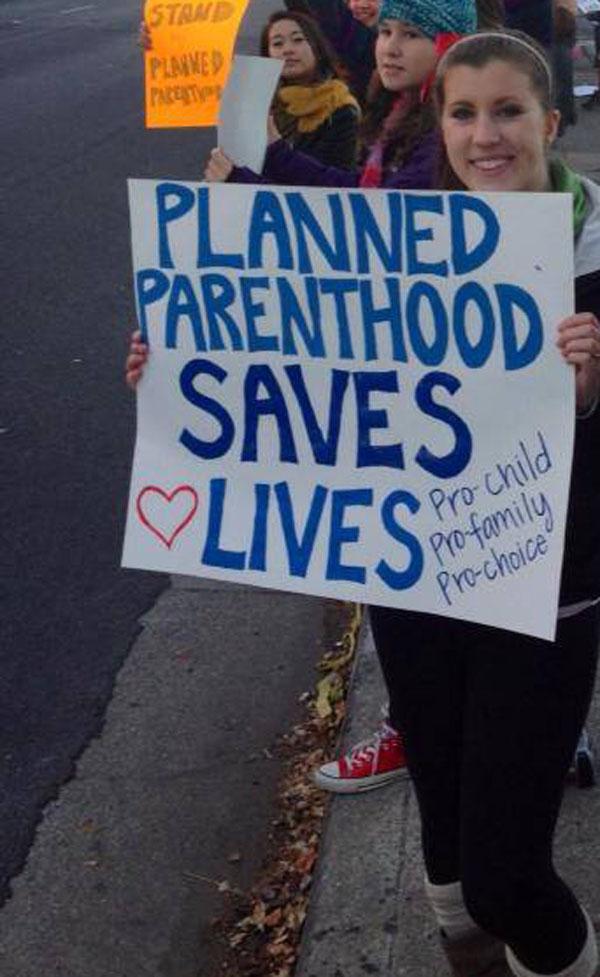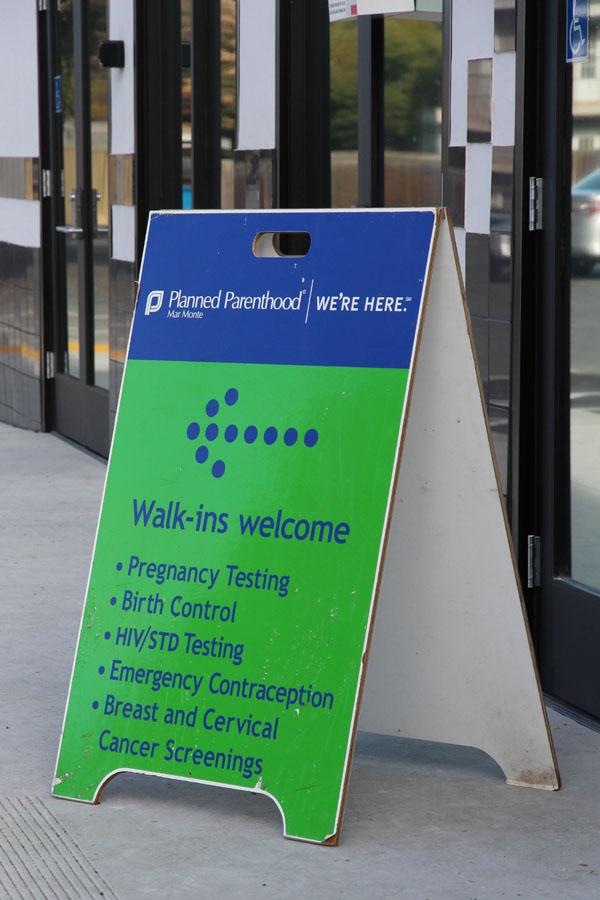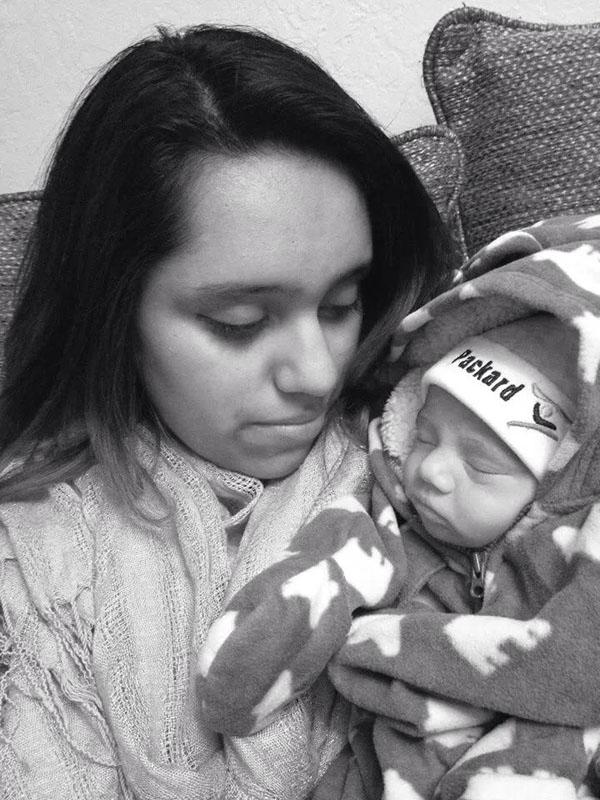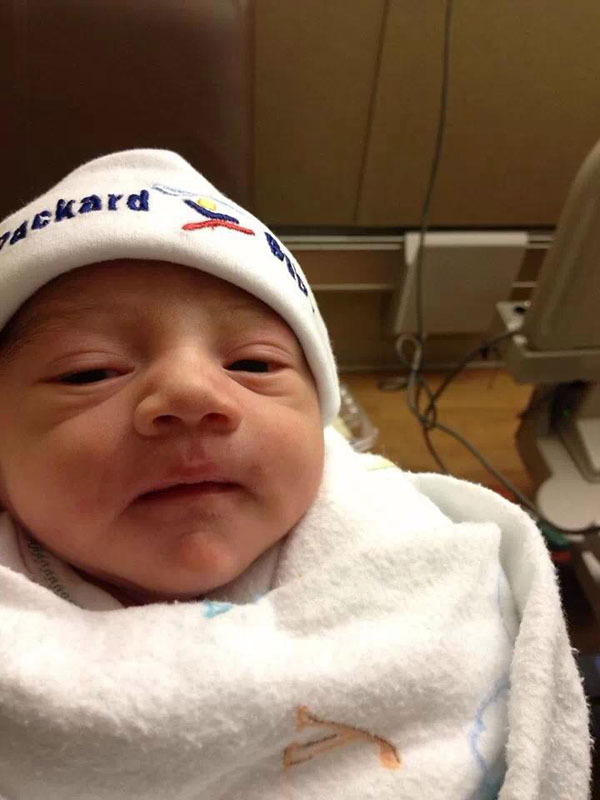
On the sidewalk in front of the newly opened Planned Parenthood in Redwood City on a cold December day, a group of approximately 15 protesters sit silently in lawn chairs planted by the busy El Camino Real. Of varying ages, some in elementary school, they hold signs protesting the access to abortion that the new health care center promises.
Palo Alto High School’s Gender Equality Club take to the adjacent sidewalk to counter-protest in support of Planned Parenthood. Teenage girls display their colorful signs to the road, chat among themselves and cheer for the cars that honk approval as they pass.
While I was at the protest with the Paly Gender Equality Club in support of Planned Parenthood, the issues surrounding reproductive health care choices are complex and deserve close analysis from all angles. This article is part of my attempt to understand more about the subject and to share it with the Verde readership in the most objective way possible.
Laws, Planned Parenthood and Misconceptions
Despite the 1973 Roe v. Wade U.S. Supreme Court decision and an array of state laws that invalidated all existing laws restricting abortion, debates, new laws and proposed laws concerning reproductive rights persist.
Last October, California became the first state since Hawaii (2006) to pass a law expanding abortion access. The new legislation allows more medical personnel, such as nurse practitioners, midwives and physician assistants to perform first-trimester abortions.
Sexually active teens may be concerned about finding access to abortion and contraception. With the recent opening of the Planned Parenthood in Redwood City, uninsured local teens who seek access to reproductive health care and assistance have a close place to go.

When senior Kelly Patterson, co-president of the Gender Equality Club, encouraged club members to counter-protest the anti-abortion protesters, she had the emotions of Planned Parenthood’s patients in mind.
“It’s hard for patients walking in [when protesters are outside],” Patterson says. “They need to know that there are also supporters.”
The protest at Planned Parenthood motivated Patterson to continue actively supporting reproductive rights.
“I was surprised by how many people drove by that were actually supporting the pro-life protesters,” Patterson says. “It just validated that we need to do more with it.”
A Gallup poll in May 2013 found that 48 percent of American adults consider themselves “pro-life,” or anti-abortion, and 45 percent consider themselves “pro-choice,” or for the legality of abortion.
According to Paly Living Skills teacher Letitia Burton, a common misconception about Planned Parenthood is that its primary service is access to contraceptives and abortion, not comprehensive family planning and health care. In reality, Planned Parenthood offers a variety of health care services in addition to abortion, including breast and cervical cancer screening, emergency contraception, counseling and ultrasounds.
“With Planned Parenthood, people just see it in terms of birth control or pregnancy termination services, but really Planned Parenthood is a full-service health clinic where anyone can go to get anything for their health needs,” Burton says.
While organizations dedicated to providing easily accessible reproductive health care like Planned Parenthood have proven effective for millions of women, according to developmental psychologist Dr. Nancy Brown, they can also cause misconceptions regarding reproductive rights.

“A lot of teens with insurance go to Planned Parenthood because they don’t understand their state rights,” Brown says. “In the state of California, you [anyone over the age of 12] have the right to receive confidential reproductive health, emotional health and substance abuse services from your provider.”
In other words, an insured teen can go to his or her normal physician and request confidential consulting and care that will not appear on his or her parent’s bill. Teens may find care from their own doctor more comforting and personal, and the doctor could also benefit by becoming aware that the teen is participating in potentially risky behavior and remembering to ensure that he or she receives the appropriate advice, vaccinations and medications.
“We can prevent unplanned pregnancies,” Brown says. “Nobody needs to get pregnant. I think a lot of people get pregnant because they don’t understand that they have access to preventative care.”
Prevention
According to Guttmacher Institute, about half of American women will have an unplanned pregnancy in their lives, and about 40 percent of those will end in abortion. Abortion rates have dropped from 1.21 million abortions in 2008 to 1.06 million in 2011.
In the decades since Roe v. Wade, although not the case in California, many states have made it mandatory for parents to grant permission to minors to get abortions unless excused by a judge. Brown worries about the dangers these laws may pose to some girls.
“In my ideal world, every parent would be the type of parent you could approach with a problem as big as an unplanned pregnancy and trust that they will help you,” Brown says. “Kids would have a family they could go to. But if they don’t, we cannot have a law that says ‘Great, you’re 16. You’re pregnant. I’m going to call your parents now and – Oh, I’m really sorry, your dad is going to beat you; or you might get disowned; or thrown out of the house.’ We can’t have that. So in my ideal world, that would not be the law, but in the real world, we need it [California law allowing minors to get abortions without parental consent].”
While Brown recognizes potential dangers of forced permissions from parents, she urges teens to try and be as open with their parents as possible because she believes open communication benefits the girl and her parents.
“More parents would be more supportive than teenagers give them credit for,” Brown says. “Most would later agree that it’s better that they know [their daughter is pregnant].”
The Palo Alto Medical Foundation is currently working on a new service on its website, entitled My Health Online, to allow teens to email their doctors asking assistance. They can request help in talking with their parents about abortion. The website’s creators hope that parents would more readily accept conversation about a teen’s sexual activity and health coming from a doctor.
The American Academy of Pediatrics recommends that doctors provide graduating high school senior girls with advance prescriptions for birth control and emergency contraception for their post-high school lives. These women could then date the prescription at the time they need the contraception, without having to search for a new doctor to prescribe it.
Bryanna Gonzalez
Paly junior Bryanna Gonzalez gave birth to a baby boy in December of 2013. Despite her situation, she still attends Paly and tries to balance her life between school and her baby.

“It’s been a struggle staying in school and not having people find out,” Gonzalez says. “It [the hardest part] was just trying to stay focused on school, and at the same time, taking care of myself and the baby.”
Though Gonzalez did not consider abortion, she felt pressured from both sides in her decision to either keep the baby or put it up for adoption.
“After someone told me that once I give up the baby, I’ll go into a deep depression, I decided to keep it,” Gonzalez says.
Although the father of her baby is no longer involved, Gonzalez’s family and close friends have remained supportive.
“In the end I was just getting all this support,” Gonzalez says. “Before, I didn’t really have anybody to help me, until everybody found out.”
Gonzalez says she is happy with her decision to keep the baby, mainly due to the support she receives from her family with taking care of her child while she continues to attend school.
While she feels that her experience is an example that keeping a baby can work out for some teens if they have sufficient support, she supports all women having the choice to do what they want with their pregnancy and baby.

“It’s really their choice,” Gonzalez says. “They shouldn’t feel pressured to do things that they do not want to do. It’s better to let them decide on what they think is best for them. It [abortion] should be an option if they want it.”
Different Situations, Different Stances
Brown says that having a baby while in high school can negatively affect the welfare of both mother and child. According to the National Campaign to Prevent Teen and Unplanned Pregnancy, only 40 percent of teen mothers finish high school, and their children typically enter kindergarten with lower levels of school readiness than children born to women in their twenties.
“You should not pay a life consequence for five stupid minutes [of unprotected sex],” Brown says.
Although she supports Planned Parenthood for providing contraceptives and affordable service, junior Kate Bredenberg is against the current legality of abortions up to 24 weeks into the pregnancy because she believes that once there is a heartbeat, typically at about six weeks according to Mayo Clinic, the fetus in the womb is a baby that deserves the basic human right to live.
“At 24 weeks, the baby looks like a baby,” Bredenberg says. “It has hair on its head, and the face is formed.”
Bredenberg supports the option of adoption for pregnant women who do not wish to keep their babies.
“You can do what you want with your body, but if you choose to have sex and you get pregnant [before you were ready], then that was your decision, and you messed up,” Bredenberg says. “You shouldn’t punish your baby for that.”
Patterson emphasizes the importance of differences in each woman’s individual situation in deciding whether abortion is the right choice for her.
“Everyone’s in different situations when they find out that you’re pregnant, and it [pregnancy] can really limit your options, especially if you’re in high school and want to go to college instead of having a baby, or if you’re addicted to drugs, or if you’re going through severe depression already,” Patterson says. “It’s important that we recognize that not every woman who has an abortion lives in a perfect world where they can support the child.”
While junior Kelly Swanson is personally against abortion, she remains undecided on whether she feels that no women should get the choice.
“I can’t decide if people should get their own choice,” Swanson says. “I personally would not have an abortion unless I was raped, but other people might have other situations like that [making abortion an acceptable choice].”
Burton partially blames the media for ignorance of the potential consequences of sex.
“Our society makes it really difficult to make that decision [to start having sex] due to the double messages that our society gives about being sexual in movies, videos, music and TV programs,” Burton says. “There’s lots of sexuality, and it’s celebrating it. A lot of what you see about teens and sexuality is sex without consequences. People think, ‘Oh well, it’s just this once, it won’t happen to me.’”
Brown highly recommends that people of all ages talk through the potential consequences of sex with their partner to ensure that they are prepared with knowledge and support before they decide to start having sex.
“If you can’t talk, then you’re really not ready to have sex,” Brown says. “If sex is easier than talk, then it’s the wrong relationship. Your [a teen’s] executive functioning is not fully developed. You really don’t have the ability to picture life ten years from now.”
Gonzalez offers advice to teens deciding to engage in sexual activity from her personal experience with an unsupportive partner.
“Just be careful about who you’re with,” Gonzalez says.
Sexual Education
Brown’s solution to providing the necessary support and information for girls to make the right sexual decisions for themselves is comprehensive sex education implemented throughout a child’s life.
“Sexuality education should start when the kid is four,” Brown says. “The more teenagers know, the less likely they are to have sex [before they’re ready].”
Brown stresses that all adults in a child’s life should be available to provide answers to children and teenagers alike regarding sexuality.
“If they ask us an honest question, we ought to give them an honest, factual answer,” Brown says. “Everywhere where people are, we should all be willing to talk, so that there’s no period stigma, no bullying, no rape, no partner violence and no unplanned pregnancy… It [sexual education] shouldn’t be a class, it should be a way of life.”
